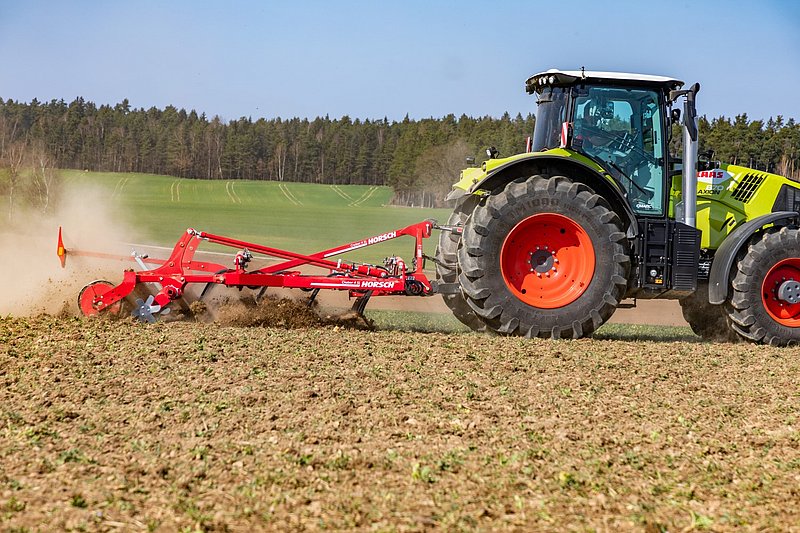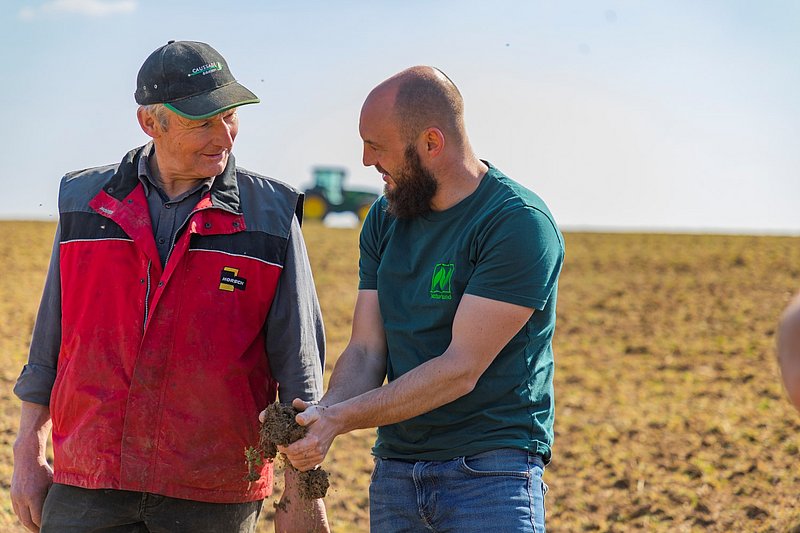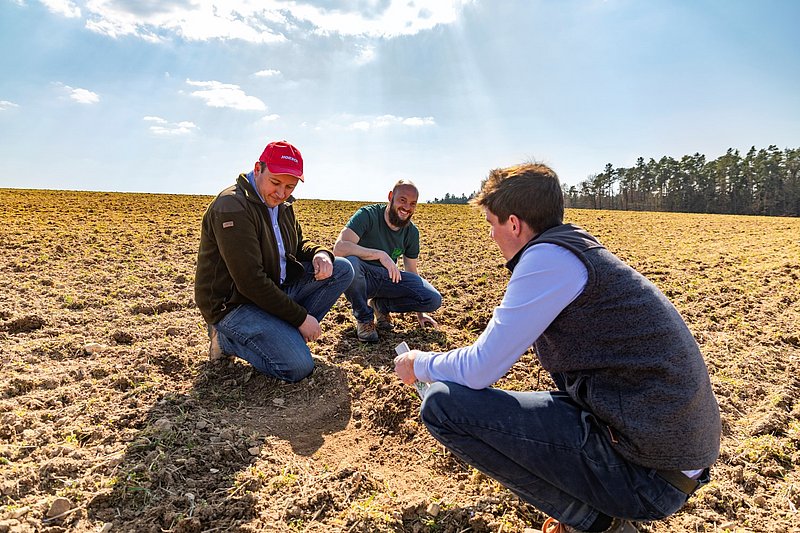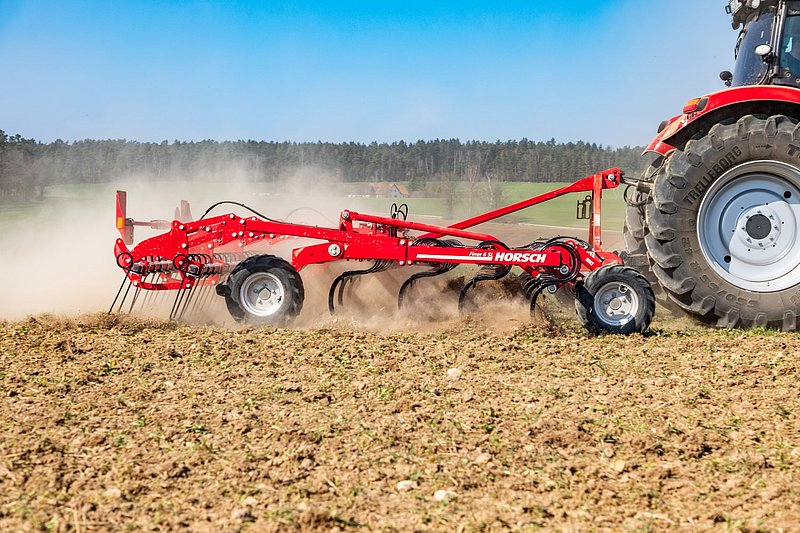
Catch crop cultivation with Finer and Cruiser – a practical comparison
What are the assets of the Finer with regard to catch crop cultivation? Where does the Cruiser lead the field? Both machines were put to the test. terraHORSCH talked to Josef Stangl, Michael Braun (HORSCH) and Konrad Maier (consultant team Naturland) about the results.
terraHORSCH: When was the practical test with the two machines carried out?
Konrad Maier: The test with the Finer SL and the Cruiser SL started on 28th March2022. Because of the weather we had to start a little bit earlier than scheduled as according to the weather forecast it was going to rain within the next few days. This pass was the first one on these fields in 2022. The objective was to dry out the catch crops that had not completely died and at the same time to remove the weeds that had developed during the winter. As a catch crop we had sowed a mixture of phacelia and oil radish, but it had developed poorly. The result was that the guiding weeds chickweed and deadnettle as well as volunteer wheat were well established.
terraHORSCH: What were the challenges?
Josef Stangl: The catch crop that should actually have frozen off survived the mild winter. Frost susceptible catch crops are a challenge if they do not freeze off properly. You have to allow for one additional pass to fight it successfully. In some regions time often is running short for this cultivation step.
Moreover, because of the deeper cultivation last year the volunteer wheat germinated from different depths. This, too, made the cultivation more difficult. The germination depths ranged between two and six centimetres. However, if you want to cut shallowly in only one pass you have to find an even horizon for the vegetation that has to be cut. A levelled field would actually be a prerequisite.
We had sown late in September. Therefore, in addition to the higher frost tolerance the population was not very lush. Spreading manure in spring left slight track depressions. The soil was very compact and slightly wavy. This is why it took us longer to adjust the machine.
Konrad Maier: Catch crops that freeze off safely are more and more becoming an issue. The main reason is that the incorporation in spring is very complex and intensive as time is short. Every pass wastes water which then is no longer available for the following crop. A well established and strong catch crop is essential as it freezes off more safely than a rather badly developed catch crop. The reason is that the glycol and sugar content in the biologically older plant is lower. They are the natural frost protection of the plant and thus it depends on them if a catch crop dies or not. To safely unroot the catch crop, the weeds and the volunteer crop in the first pass, we went for a slightly deeper cultivation at a depth of 5 cm. Two days later we spread liquid manure with StripTill. Three days after that we cultivated the field again with a harrow to remove the earth from the organic matter and its roots and place them on the surface to encourage the drying of the plant. We then sowed maize.
Josef Stangl: This year, we increasingly noticed soils with structural problems. In light soils this isn’t a big problem but in heavy, clayey soils it is. With the rough clods you often need more passes to crush the large clods. And, of course, you have to worry if the maize can germinate and root properly.
But eventually the maize simply has to be sown. During two weeks in April the conditions were relatively good. After heavy rainfalls it often still was too wet at the beginning of May.
Konrad Maier: I can only confirm the structural problems of the soil this year. On 13th April 2022, at a Naturland harrow event we harrowed several fields south of Regensburg. In the area below 10 cm the soils partly were very wet. This delayed warming and did not encourage the root development. The humidity in the subsoil contains a big risk of compaction during the cultivation in spring. Especially with organic fertilisation the weights often are too high. Every farmer should check the moisture in the soil in advance. Our experiences with fields where the previous crop was grain maize were good. The conditions were almost optimum – loose, well aerated soils which were able to warm fast.
Josef Stangl: For example, on the grain maize fields in Schwandorf we combined late last year, the yields were good. Accordingly, a lot of plant mass remained on the field. The whole winter there was straw on the topsoil layer and in spring we noticed how loose the soil was underneath. With the other mediocrely and badly developed catch crops, legumes or even after silage maize the soil in spring was not this loose. It was very compacted. Well, the soils are rather sandy where compaction, of course, is more intensive if they are not cultivated. But my theory is that because of the rainfalls in winter the soils were washed out superficially and lacked lime and the glue for the soil structure. It was very dry in the past two years. We kind of pulverised the soil during tillage. And the finer it was the more compacted and crusty it became.
terraHORSCH: Can you already draw any conclusions from the previous observations?
Konrad Maier: We are wondering if there might have been alternatives. Maybe a deep loosening in autumn would have been more successful. I advised against a penetration deeper than 15 cm. The risk of creating large clods is too high as it is very difficult to crush them. We will keep an eye on the maize and observe its development. We hope that the roots of the maize will develop well and thus will quickly penetrate the compacted soil.

Josef Stangl: If there is rain, it will not be serious. With a certain humidity penetration and the corresponding swelling small disturbing layers are less dramatic for the emergence of maize. The problem only aggravates if it is very dry as the compact layer will become even more compact and solid and hardens. This might be problematic for the seedling and the germination roots. It would for example be interesting to take another look at the roots when the maize is in the five- to eight-leaf stage. Just dig to the topsoil and see if the roots perhaps mainly extend alongside the seed furrow and not evenly in all directions.
Konrad Maier: For us the soil is the basis. We attach major importance to a conserving cultivation. Only if we encourage the soil and maintain, even improve, its structure and humus content, we will be able to manage it in the long term. This year, we once again saw that there isn’t one single strategy for tillage. We have to remain open and flexible. In my opinion, this is very important.
Michael Braun: Where we worked with the rotary harrow, the surface is very fine. But the question is: Do we have enough seed-soil contact especially for large seeds like soya? Soya needs much water for germination. Safe emergence is not always a given. Moreover, you have to invest quite a lot with regard to the inoculation. And if you do not offer the bacterium an excellent habitat – and a dry soil isn’t a good habitat – you will give away part of the potential of the rhizobia.

Konrad Maier: At our sites water supply in the germination stage is crucial. Especially for maize and soya, the demand for germination water is very high. If this demand cannot be covered, there will be gaps and the population will wash out irregularly which later on will be a problem for the tillage passes with hoe and harrow. For us, it was ideal to place the seed on the water-bearing layer. The water supply is guaranteed, and you can rather easily plan the population. The water-bearing layer mainly results from the rising capillary water. The deeper you cultivate the soil in spring, the deeper down moves the capillary layer. Thus, for us, a shallow tillage in spring is some kind of an insurance for a safe emergence. A depth of 6 cm is completely acceptable as the placement depth helps that we can light harrow the crop again before it breaks through the ground. The only disadvantage of a deep placement is that on our sites we have to keep up a soil temperature of 8° C – safely for ten days – to not overtax the reserves of the seedling.
Michael Braun: As an alternative, you could consider to clear the furrow. Some of our customers do it. If the water is at 8 cm, the seed is placed in the wet horizon and then is covered with 5 m of earth. In this case, mechanical population control has to be adapted to the surface layout.
Josef Stangl: In case of populations with gaps there is the problem that other non-crop plants, too, find their way into these gaps. Therefore, in spring, two passes are often better than one for a better and more even emergence. In organic farming, this already is quite common. Because of the high fuel costs, it, of course, is quite tempting. But according to experience, farms that save on tillage have to use more chemical products afterwards.

Whether Finer or Cruiser – both convinced to the same degree with regard to catch crop cultivation. The overlapping of the respective points, the perfect depth control of the tines and the exact adjustment of the machine were very important. Whereas the Cruiser with packer develops its potential with regard to stubble cultivation, distributes straw and makes seeds emerge, the Finer is ideal to keep the fields black and to fight persistent root weeds by means of the harrow.
